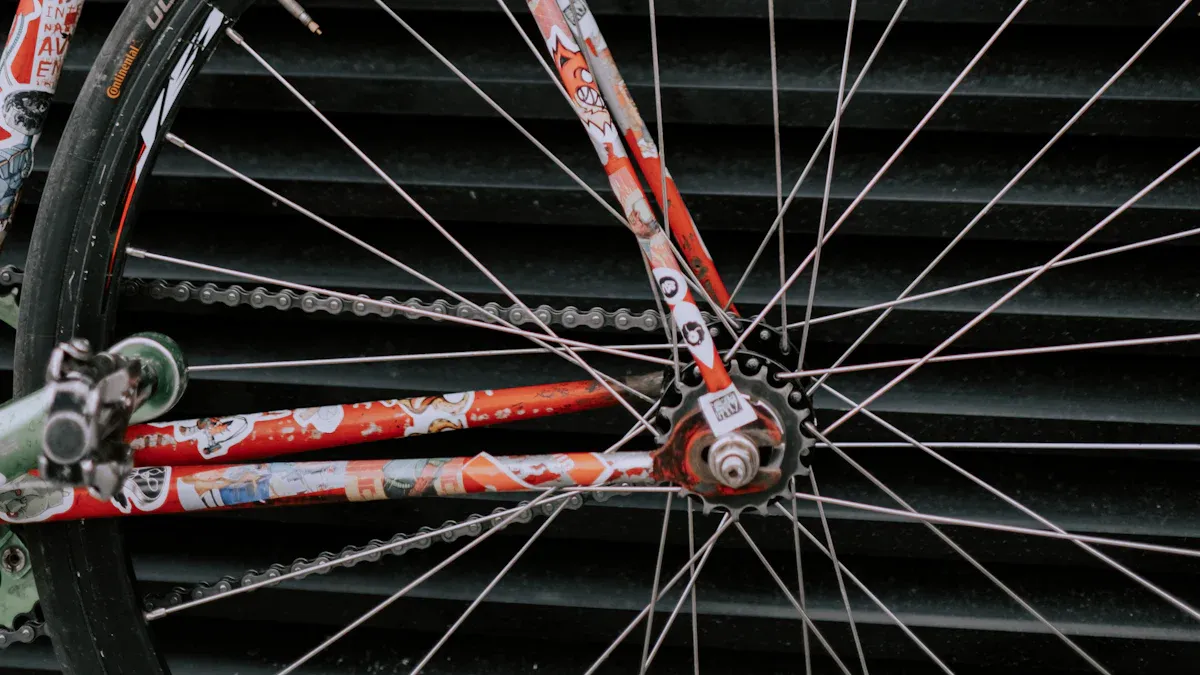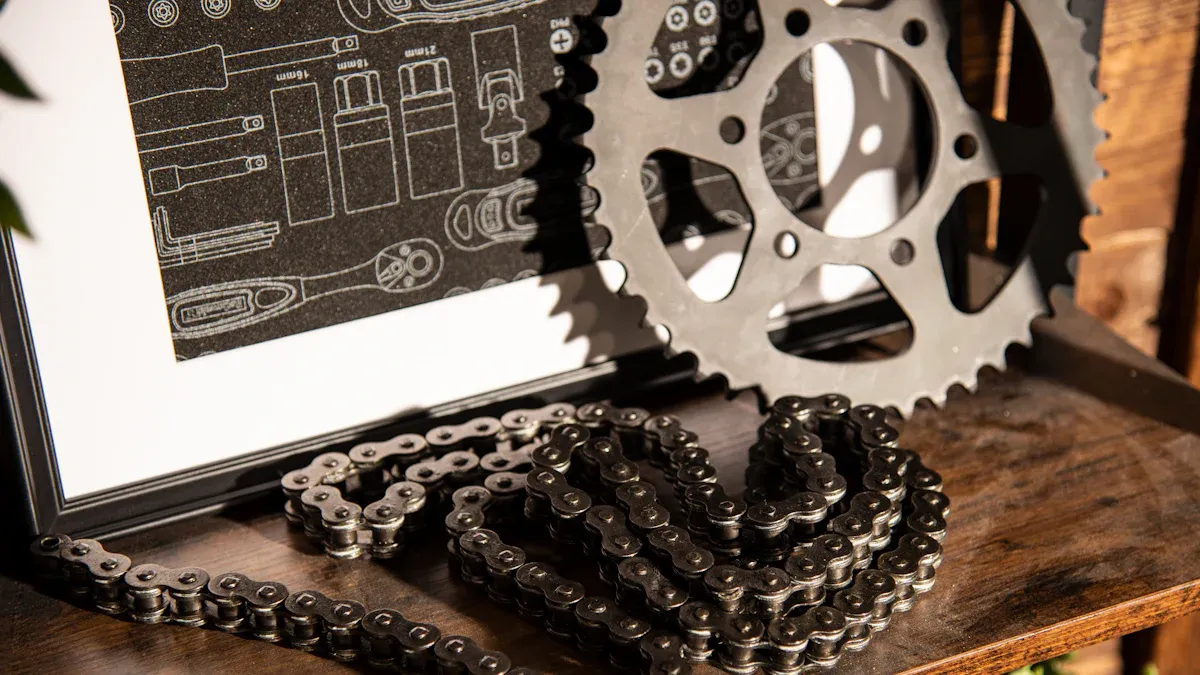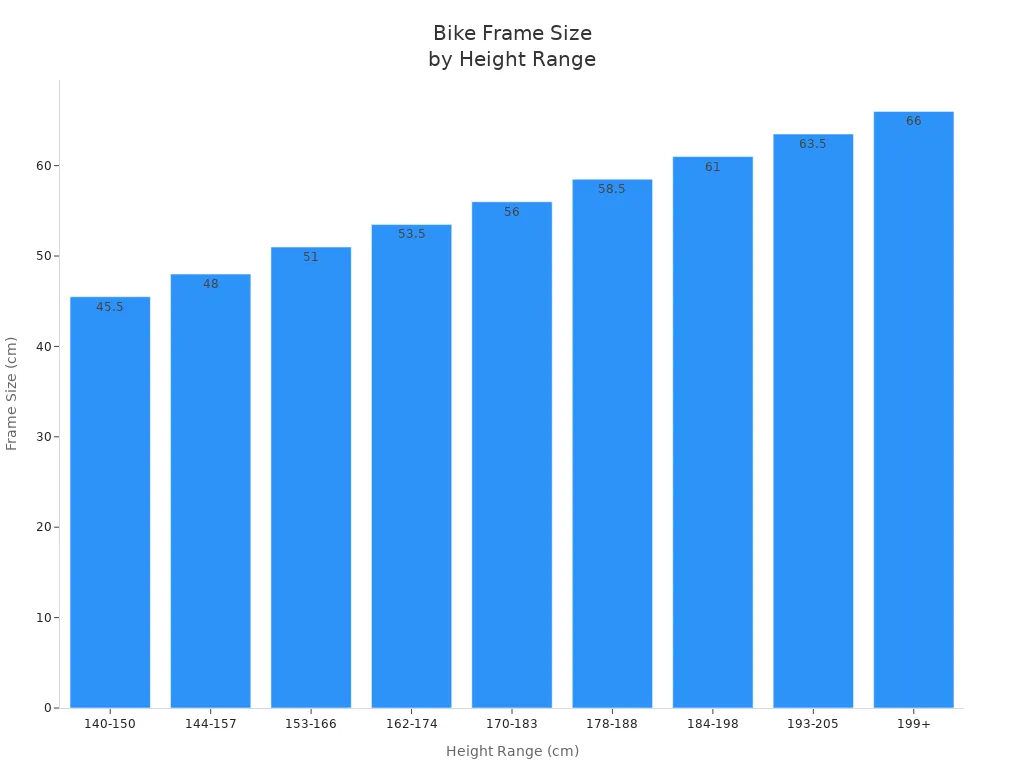
A bike frame chart shows you which bike size fits your body best. This chart uses your measurements to match you with the right frame. When you ride a bike that fits, you feel more comfortable and in control. Studies show that the right bike size helps you pedal better and lowers your risk of injury by keeping your joints in safe positions. Using a bike frame chart can make every ride safer and more fun.
Key Takeaways
Bike frame charts show you which bike size fits you. They match your body size to the bike frame size. Key measurements like seat tube length, reach, and stack matter. These measurements change how safe and comfy your ride feels. Different bikes use different ways to measure size. Always look at the chart for the bike you want. Picking the right size makes riding easier and safer. It helps you perform better and lowers your chance of getting hurt. Measure your height and inseam with care. Use the chart to help you choose. Try riding the bike to see if it fits you well.
What Is a Bike Frame Chart

A bike frame chart helps you pick the right bike size. It shows how frame sizes match your body. Companies make these charts to help you choose a bike for your height, inseam, and how you ride. Experts say a bike frame chart is a special geometry chart. It uses standard measurements like Stack and Reach. Stack is the up-and-down distance from the bottom bracket to the top of the head tube. Reach is the side-to-side distance between these points. These numbers help you get a better fit than just using seat tube length or size labels.
Key Measurements
When you check a bike frame chart, you see important numbers. These help you compare bikes and pick the best one for you.
Seat tube length: This is the usual size number. It is measured from the middle of the bottom bracket to the top of the top tube.
Reach: This is the side-to-side distance from the middle of the bottom bracket to the middle of the headset. It changes how far you stretch on the bike.
Stack: This is the up-and-down distance from the middle of the bottom bracket to the middle of the headset. It shows if you will sit upright or lean forward.
Headtube length: This changes how the bike steers and how high your handlebars are.
Seat tube angle: This lets skilled riders adjust where their seat goes.
Tip: Always look at these numbers on the sizing chart before you buy a bike. They help you stay comfy and make sure the bike fits you.
Types of Bike Frame Charts
Bike frame charts are different for each bike type. Road, mountain, and kids’ bikes use different sizing ways.
Bike Type | Measurement Unit | Sizing Basis | Notes |
|---|---|---|---|
Road Bikes | Centimeters (cm) | Frame size based on seat tube length | Size charts link rider height and inseam to frame size; more detailed. |
Mountain Bikes | Inches (in) | Frame size in inches or size labels | Charts relate inseam and height to frame size; reflects riding style. |
Kids’ Bikes | Wheel diameter | Wheel size instead of frame size | Larger size steps; sized differently from adult bikes. |
Companies use different ways to measure frame size. Most road bikes use effective top tube length. This tells you how long the bike feels. Mountain bikes often use seat tube length. But adjustable seatposts can make this less exact. Kids’ bikes use wheel size because their frames are much smaller.
Why Choose the Right Bike Size

Comfort and Performance
When you choose the right bike size, you set yourself up for a comfortable ride. The perfect fit helps your body line up with the bike’s shape. You feel less strain on your knees, back, and wrists. Your muscles work together, so you pedal smoothly and use less energy. You stay motivated to ride longer because you do not get tired as quickly. Good bike sizing also helps your blood flow and keeps your weight balanced. You sit in a position that lets you control the bike easily, whether you want to ride fast or just enjoy the scenery.
If your bike does not fit, you may notice pain in your back or wrists. You might feel tired faster because your legs and arms work harder. You could also have trouble reaching the handlebars or pedals, which makes riding less fun.
Here are some common problems from poor bike sizing:
Poor posture leads to back pain that seat or handlebar changes cannot fix.
You feel more tired because you lose pedaling efficiency.
Wrist pain happens when you stretch too far or sit too close to the handlebars.
You lose control, which can make riding unsafe.
Professional cyclists often pick smaller frames for speed and power. They use longer seatposts and stems for an aggressive position. Recreational riders usually want comfort, so they choose larger frames and sit more upright. Both groups need a perfect fit for their style.
Safety and Injury Prevention
The right size bike keeps you safe and helps prevent injuries. When your bike fits, your knees bend at the right angle, and your joints move smoothly. Studies show that even a small change in saddle height can affect your knees. If your saddle is too low or too high, you risk knee pain or overuse injuries. You also protect your neck, shoulders, elbows, and hips from stress and fatigue.
Common Injuries and Causes | Prevention / Notes | |
|---|---|---|
Neck | Pain from poor posture | Sit upright; stretch neck muscles |
Shoulders | Stress from wrong saddle or handlebar height | Adjust saddle and handlebars |
Elbows | Tendinitis from gripping too hard | Change hand position often |
Wrists and Hands | Pressure injuries from low handlebars or small frames | Move hands often; check handlebar height |
Low Back | Pain from poor fit | Keep lumbar curve; stretch and strengthen muscles |
Hips | Tendinitis from bad fit or technique | Get correct bike fit |
Knees | Tendinitis, pain from low saddle height | Check seat height and pedal stance |
Ankles and Feet | Tendinitis from abnormal stress | Use proper shoes or orthotics |
Saddle Area | Use good saddle design and padding |
You can avoid most injuries by making sure your bike fits your body. Saddle sores, numbness, and joint pain often come from riding a bike that does not match your size. Advances in saddle design help, but you still need to choose the right bike size for your health and safety.
Bike Size Guide
How Do You Figure Out Your Bike Size
You can find your best bike fit by measuring your height and inseam. These two numbers help you match your body to the right bike frame. Follow these steps to get accurate measurements:
Place your feet about 6-8 inches apart, just like you would on a bike.
Put a large hardcover book between your legs and pull it up gently to copy the feeling of sitting on a bike saddle.
Ask a friend to measure from the top of the book to the floor. This is your cycling inseam.
Have your friend mark the top of your head and measure from the floor to this mark. This is your height.
For extra accuracy, stretch your arms out and measure your wingspan from fingertip to fingertip. This helps you find the right bike reach.
Note: Do not use your pants inseam for bike sizing. The cycling inseam is different and gives a better fit.
When you stand over a bike, make sure you have at least 1-2 inches of space between your body and the top tube. This space keeps you safe and comfortable.
Height and inseam give you a strong starting point, but they do not tell the whole story. Some riders have longer legs or arms than others with the same height. For example, a 5’7″ rider with a long inseam may need a bigger frame than someone of the same height. Your riding style, comfort, and flexibility also matter. Test rides and expert advice help you find the best fit beyond just numbers.
Use the right measuring method for accuracy.
These numbers are a guide, not a rule.
Try the bike and ask for help if you feel unsure.
What Size Bike Should I Get
You can use your measurements to pick a frame size from a bike size chart. Most brands offer charts that match your height and inseam to a frame size. Here is a sample chart for adult bikes:
Recommended Bike Frame Sizes by Height Range
Height Range (cm) | Frame Size (cm) | Standard Size Label |
|---|---|---|
140 – 150 | 45 – 46 | XXS |
144 – 157 | 47 – 49 | XS |
153 – 166 | 50 – 52 | S |
162 – 174 | 53 – 54 | M |
170 – 183 | 55 – 57 | L |
178 – 188 | 58 – 59 | XL |
184 – 198 | 60 – 62 | XL |
193 – 205 | 63 – 64 | XXL |
199+ | 65 – 67 | XXL |

You will see that adult bike sizing uses frame size in centimeters or inches. Road bike sizing often uses centimeters and measures the seat tube. Mountain bike sizing uses inches or size labels like S, M, L, and XL. Kid bike sizing works differently. Kids’ bikes use wheel size, not frame size, to match the bike to the child’s height and skill.
Road, Mountain, and Kids’ Bike Size Differences
Road bikes use frame size in centimeters. The seat tube length is the main number. If you have long arms, you may want to size up. If you want a lighter or more upright bike, size down.
Mountain bikes use frame size in inches or size labels. The fit depends on your inseam and height. Wheel size (26″, 27.5″, 29″) can change how the bike feels, but frame size is most important.
Kids’ bikes use wheel size, such as 12″, 16″, 20″, or 24″. The right size depends on the child’s height, inseam, and confidence. Always check if your child can touch the ground and control the bike.
Bike Type | Sizing Method | Main Measurement | Notes |
|---|---|---|---|
Road Bike | Frame size (cm) | Seat tube length | Size up for long arms; size down for upright position |
Mountain Bike | Frame size (in/S-XL) | Inseam/height | Wheel size affects ride feel, not frame size |
Kids’ Bike | Wheel size (inches) | Height/inseam | Choose by wheel size; check control and confidence |
Tip: For kids, always pick a bike they can handle safely. Do not size up unless they can control the bigger bike.
Wheel Size Considerations
Wheel size plays a big role in kid bike sizing. For children, the wheel diameter (12″, 16″, 20″, 24″, 26″) matches their stage of growth and riding skill. Parents often use age and height to pick the right wheel size. As kids grow, they move up to bigger wheels. For adult bikes, wheel size matters less for frame fit, except in mountain bike sizing where it changes how the bike handles. If you are shorter than 155 cm (about 5’1″), you may need a kids’ bike with a smaller wheel.
Bike size considerations include your height, inseam, riding style, and the type of bike you want. Always use a bike size guide to compare your numbers to the chart, but remember that comfort and control are most important.
How to Use a Bike Frame Chart
Matching Measurements
You start by taking proper measurements of your height and inseam. Stand straight against a wall without shoes and use a book to measure your inseam, just like you learned earlier. Next, find a bike frame chart for your bike type. Look for the row that matches your height and inseam. This step helps you narrow down your options for frame size.
After you find your recommended size, check the bike’s top tube length and standover height. These numbers matter because your torso and arm length affect how you reach the handlebars. Two people with the same height may need different frames if their body proportions differ. For example, a longer torso means you might need a longer top tube. Always use a chart that matches your bike type, since mountain bike sizing uses different numbers than road bikes.
Here is a quick checklist for how to check if a bike is the right size:
Stand over the bike’s top tube. You should have 1-2 inches of clearance.
Sit on the saddle and reach for the handlebars. Your arms should feel relaxed, not stretched.
Pedal a few times. Your knees should bend slightly at the bottom of each stroke.
Tip: A test ride helps you feel if the bike gives you a perfect fit before you buy.
Adjust for Riding Style
Your riding style changes which frame size feels best. If you want speed and a stretched-out position, you may size up for more reach and stability. Riders who like quick turns or trail riding often size down for better control. Park riders pick smaller frames for agility, while trail riders choose larger frames for comfort.
You can also adjust the bike after picking a frame. Change the saddle height, handlebar width, or stem length to match your body. Remember, a bike frame chart gives you a starting point. Professional fitting fine-tunes your setup and helps you avoid mistakes like picking the wrong size or ignoring your body’s needs. If you feel unsure, ask a local bike shop for help.
Bike frame charts show you which bike fits your body and how you ride. When you use these charts and measure yourself, you feel more comfortable. You also have better control and ride better. Research says the right bike size can stop pain and make biking more fun. Before you buy a bike, look at trusted websites like eBicycles.com or IceBike.org for the latest size guides. If you are not sure or are between sizes, ask a bike shop expert for help. 🚲
FAQ
How do you know if your bike is the wrong size?
You may feel pain in your knees, back, or wrists. You might struggle to reach the handlebars or pedals. If you feel unsafe or uncomfortable, your bike size may not fit you.
Tip: Always test ride before buying.
Can you adjust a bike that feels too big or small?
You can change the saddle height, stem length, or handlebar position. These adjustments help you get a better fit. If the frame is much too big or small, you may need a different bike.
Adjustment | What It Changes |
|---|---|
Leg comfort | |
Stem Length | Reach to handlebars |
Handlebar Angle | Wrist position |
Do all brands use the same sizing chart?
Brands use different sizing charts. You should always check the chart for the brand you want. Frame measurements and labels may change from one company to another.
Note: Never assume sizes match across brands.
What is standover height and why does it matter?
Standover height is the space between the top tube and your body when you stand over the bike. You need at least 1-2 inches of clearance. This keeps you safe and helps you avoid injury.
🚲 Standover height helps you ride with confidence.
